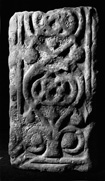Select a site alphabetically from the choices shown in the box below. Alternatively, browse sculptural examples using the Forward/Back buttons.
Chapters for this volume, along with copies of original in-text images, are available here.
Object type: Lower part of cross-shaft
Measurements: H. 46 cm (18 in); W. 25.5 > 24.5 cm (10 > 9.5 in); D. 18 > 17.5 cm (7.25 > 7 in)
Stone type: Medium-grained red sandstone (Penrith sandstone)
Plate numbers in printed volume: 476 - 9
Corpus volume reference: Vol 2 p. 134-135
(There may be more views or larger images available for this item. Click on the thumbnail image to view.)
The shaft is edged by a double roll moulding.
A (broad): The mouldings frame the base of the panel, on which is set a medallion plant-scroll of which one complete and one nearly complete medallion survive. The plant springs from a bush-like base: two tendrils spring on either side and enclose two round globe-like fruits. A short triangular leaf on a short stem sprouts from the centre of the bush, and is enclosed by the two strands of the medallion. In the centre of the medallion two strands which fall from the node form a plant knot and terminate in two globe-like fruits. The medallion above is similarly composed.
B (narrow): One complete register of alternating half pattern C with a pattern E terminal at the base and the beginnings of another register at the top. A line of six pellets fills the spaces between the knots.
C (broad): Entirely obliterated save for the double roll moulding on the left.
D (narrow): A panel of key pattern (Allen 1903, no. 928), divided by a single line.
Although the combination of motifs on this shaft is unique in Cumbria, the style of cutting with neat, fine strands in the plant and interlace panels, as well as the individual motifs are all capable of being paralleled elsewhere in the region. The plant scroll on face A which combines a bush and medallion scroll, however, reflects a preference for bush scroll motifs and for knotted plant stems which is widely dispersed in the British Isles from Rosemarkie in Rosshire (Henderson 1983, fig. 112a), through Northumbria at sites such as Carlisle 3 (Ills. 203–5), Norham, Northumberland (Ill. 675) or Cundall, Yorkshire (Collingwood 1927a, fig. 32), to Mercia, as at Fletton, Huntingdonshire (Kendrick 1938, pl. LXXIV) and Wessex, for example at Winchester and Whitchurch, Hampshire (Tweddle 1983, fig. 4). The bush scroll with globe-like berries may be most closely paralleled in the north in another medium – the impressed design on the leather book cover of the Stonyhurst Gospels (Kendrick 1938, pl. XLIII). Comparable 'globes' of fruit are also a feature of Yorkshire plant scrolls, as at Otley (Cramp 1970, pl. 42, 1), Croft (Kendrick 1938, pl. LXI), and St Mary Bishophill Junior, York, (Collingwood 1927a, fig. 147); and in Wiltshire at Codford St Peter (Kendrick 1938, pl. LXXV), as well as in the scrolls cited above for Rosemarkie, Carlisle 3 and Norham. The open, widely spaced loops in the interlace on face B together with the free pellets can be compared with Lowther 2, (Ill. 435), whilst the subdivided key patterns are comparable with Irton 1 (Ill. 357). This piece confirms the artistic originality of the western area of Northumbria but also demonstrates that there is no stylistic isolation in that region.



